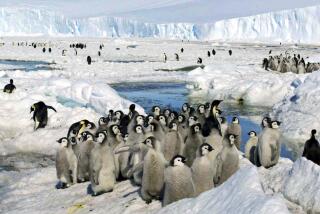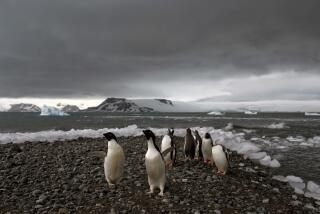On a Clear Day, Operation Deep Freeze Pilots Can See Nowhere : Antarctic: U.S. Naval Support Force fliers must be ready for anything from zero-visibility to unexpected and terrifying volcanic eruption.
- Share via
MCMURDO STATION, Antarctica — Sometimes it’s like flying inside a giant Ping-pong ball. Pilots can’t tell where sky ends and land begins.
At other times, they can see forever in the cleanest, driest, coldest air on Earth.
With almost no warning, a clear day can become a zero-visibility white sheet. At all times, the pilots of Operation Deep Freeze, Antarctica’s U.S. Naval Support Force, must be ready for anything.
“This place will take your life in a heartbeat if you don’t pay attention,” said Lt. Dennis L. Alston of Lake Charles, La., a helicopter pilot.
Deep Freeze is a “one-of-a-kind” flight service, boasts Capt. Jack Rector, its commander. The only passengers and cargo come from the National Science Foundation, the federal agency that oversees American research on this frozen continent.
The workhorses of the operation are two types of aircraft: seven 1960s-vintage ski-equipped, four-engine turboprop LC-130 Hercules transport planes and six twin-engine UH-1N Huey helicopters.
Flights are scheduled around the clock during austral summer--winter in the Northern Hemisphere--when the sun shines overhead 24 hours a day.
At the end of February, the last Hercs fly to Christchurch, New Zealand, abandoning McMurdo Station, the South Pole and their permanently iced runways to the dark austral winter. In midwinter, a lone U.S. Air Force C-141 Starlifter drops long-awaited supplies by parachute to the few die-hards on the ice.
Deep Freeze’s home base is McMurdo, the logistical center for Antarctica’s largest scientific community. The skull and crossbones flies below the Stars and Stripes atop the helicopter hangar. The chopper pilots are nicknamed “ice pirates.” A sign in the hangar humorously identifies them as “a subsidiary of Penguin Airlines.”
Ice pirates like Lt. John E. Dell of Redding, Calif., routinely have terrifying tales to tell. His worst experience occurred in October 1992 while searching for an overdue Huey near Mount Erebus, a 12,448-foot active volcano.
The temperature was 5 degrees F. Winds of 30 to 60 knots whipped the snow to zero visibility. The search team had to land in conditions far beyond the safety margin. Dell found the bodies of two New Zealand scientists. Three men had died; two survived.
“I swear I just aged another five years,” the young pilot wrote his fiancee. “I had never seen a dead body before this accident. I wish I never do again.”
Adverse weather has forced virtually every helicopter crew member at McMurdo to stay overnight at some field camp. All passengers on Hercs and choppers are weighed down by a bulky orange bag containing extra clothing. The aircraft carry survival gear and food.
“There’s no way you can really train people for these conditions,” Rector said. “It’s probably fairly impressive how good the safety record has been.”
Between 1946 and 1992, aircraft accidents related to the U.S. Antarctic program have killed 35 people, according to National Science Foundation records.
Many of the LC-130 flights regularly shuttle equipment and passengers the 2,377 miles between Christchurch and McMurdo, and the 840 miles between McMurdo and the U.S. Amundsen-Scott South Pole Station.
The annual mean temperature at the pole is minus 56 F. To prevent freezing, transport engines are never turned off during unloading, refueling and reloading.
More challenging to the Herc pilots are runs to distant scientific field camps. “I have landed the Herc in places where no man has ever set foot before,” Rector tells National Geographic.
Blown snow can conceal the deep crevasses that split the Antarctic ice. To learn how to read subtle shadows, LC-130 pilots receive the same type of instruction as astronauts.
“Basically, this is the largest bush plane in the world,” said Navy Lt. Cmdr. Guy Esten of Oxnard, Calif., a Hercules commander.
Unlike the helicopters, which rely mainly on visual flight rules, instrument landings aren’t uncommon for the Hercs. In whiteouts, when ice and sky merge into one white mass, pilots can experience a kind of vertigo. “It’s like a milk sea,” Esten said. “You have to trust your instruments.”
The helicopters and most of the Hercs are manned by crews from Point Mugu Naval Air Station in California. National guardsmen from Stratton Air Base in Glenville, N.Y., are at the controls of the other Hercs.
Occasionally the durable transports are used for emergency missions. The most recent was in late December, when a Norwegian adventurer fell to his death in a deep crevasse about 575 miles from the South Pole.
When an LC-130 was unable to land, a de Havilland Twin Otter bush plane, flown by Canadian pilots under contract to the National Science Foundation, landed two miles away and evacuated three survivors to the pole.
In November 1992, Lt. Harrison Heysel had to fly across the continent to rescue a man who had broken his leg in a tractor accident at South Africa’s research station. After landing in drifting snow where no plane had ever touched down, Heysel needed 10 tries to take off from the frozen terrain with the injured man. The battered plane required extensive repairs.
The shorter-range, versatile Hueys ferry supplies and scientists to field camps closer to McMurdo. Flying them is one of the coveted assignments for Navy helicopter pilots, who typically serve three-year Antarctic tours.
“It’s the last frontier, a unique place on Earth,” said one of the pilots, Lt. William W. Riley of New Orleans. “That’s what really draws a lot of us down here. You have to become a better pilot to exist here.”
More to Read
Sign up for Essential California
The most important California stories and recommendations in your inbox every morning.
You may occasionally receive promotional content from the Los Angeles Times.









